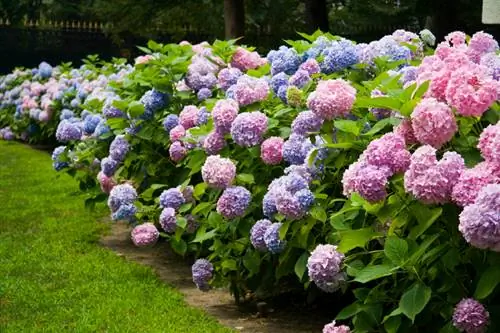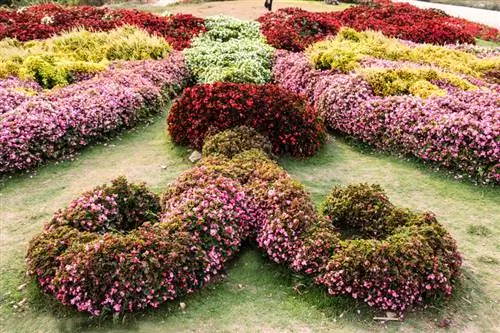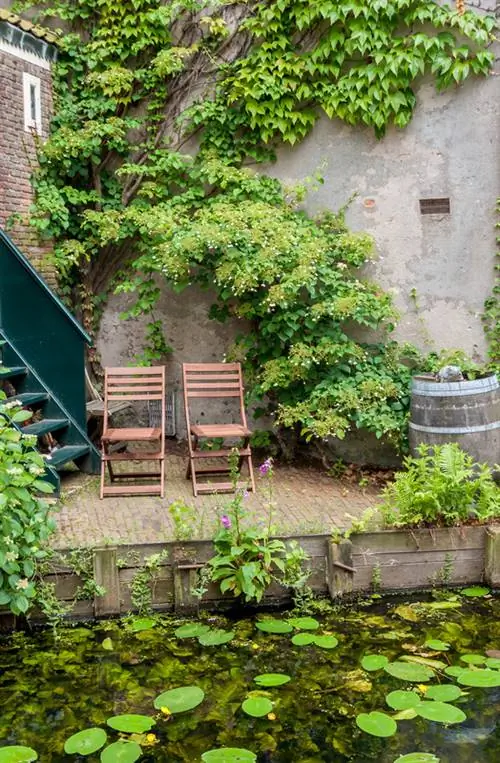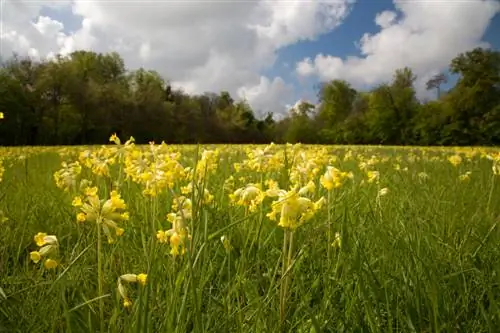- Author admin [email protected].
- Public 2023-12-16 16:46.
- Last modified 2025-06-01 06:02.
Richly blooming hydrangeas are a feast for the eyes and enchant gardens and parks with their romantic, colorful flower balls. If the site conditions are right, the shrub is surprisingly easy to care for as a container or outdoor plant. We have summarized the most important care tips for you.
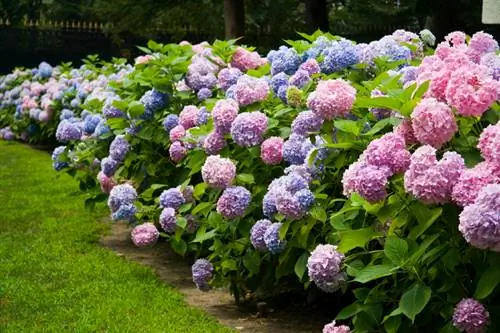
What should you consider when caring for hydrangeas?
Hydrangea care includes regular watering, fertilizing during the growing season, the correct pH value for flower color, careful pruning depending on the variety, removing flowers, repotting container plants, winter protection and pest control if necessary.
How much water does the hydrangea need?
The botanical name of the hydrangea is Hydrangea. It comes from Greek and means “water slurper”. This expresses the pretty flowering shrub's preference for humus-rich and well-moisturized soils. The hydrangea doesn't like drought at all, as it evaporates a lot of water over its large leaf surface.
In dry or sunny weather, the hydrangea needs regular watering. Both hydrangeas in pots and hydrangeas transplanted outdoors must never dry out, otherwise the plant will wilt. However, you should not overwater the shrub, because the hydrangea is also sensitive to waterlogging.
Water outdoor hydrangeas when the soil feels dry at a depth of a few centimeters. For large potted hydrangeas, we recommend using a moisture meter, which reliably determines the water content in the middle of the pot ball.
How often do you have to fertilize hydrangeas?
Regular fertilization is important so that the hydrangea has enough strength to produce numerous flowers. Fertilization takes place during the growing season from May to July. Afterwards, refrain from applying any further fertilizer so that the shoots of the hydrangea can mature until winter.
Fertilize the hydrangea preferably with special hydrangea fertilizer, as this is nitrogen-based and contains little phosphorus. Azalea and rhododendron fertilizers are also suitable.
How do the flowers turn blue?
For pink hydrangea flowers to turn blue, the pH of the soil must be acidic. Aluminum is responsible for the blue color, which must be supplied to the plant using commercially available blue dyes or potassium alum from the pharmacy.
How to prune hydrangeas?
How often the hydrangea needs to be cut depends on the respective variety. If you care for a hydrangea on the balcony or garden, you should keep the plant label safe when purchasing it.
For farmer's hydrangeas and climbing hydrangeas, it is sufficient to remove the dead or frozen parts of the plant in early spring. Since these hydrangeas produce their flowers the previous year, the plant will no longer bloom as profusely if it is cut too heavily.
Pranicle hydrangeas, on the other hand, tolerate severe pruning well. If you care for forest hydrangeas or oak-leaf hydrangeas, you can also prune these species more heavily and thereby limit their growth.
Removing faded flowers
You should not simply cut out the flowers, but carefully break them out. This promotes the formation of new buds.
Relocating hydrangeas - is that possible?
If you care for a hydrangea, you should leave it in its place if possible, because the plant is extremely loyal to the soil. If it is unavoidable to move the hydrangea, this should never be done in the summer months when it is in full bloom. The best time for this measure is autumn, when the hydrangea has already bloomed. Alternatively, you can move the hydrangea in the spring before the flowering period.
Repotting potted plants
If you are caring for a potted hydrangea, spring is the best time of year to repot the plants. Place the hydrangea in a sufficiently large planter. It should be about a third larger than the previous one. This is not only necessary to give the roots plenty of room to grow. A larger pot also holds significantly more substrate, which serves as water storage. It is recommended to add a drainage layer of expanded clay to the planter. This prevents the substrate from clogging the drainage hole and effectively prevents waterlogging.
Is the hydrangea hardy?
Almost all of the hydrangeas native to our gardens are relatively hardy and can survive cold periods well with appropriate winter protection. Panicle hydrangeas are extremely frost-resistant and can survive longer periods of cold in harsher areas.
Bottom hydrangeas should only be overwintered outdoors in a sufficiently large container and with good winter protection. It is better to care for the beauties in a frost-free room during the cold season.
Is the hydrangea susceptible to diseases or pests?
The hydrangea is quite robust and not very susceptible to diseases and pests. Here is a brief overview of the most common malware:
Diseases
hydrangea virus infection
This hydrangea disease is very feared because there is still no effective remedy. The highly contagious plant disease, which is caused by mycoplasma or viruses, causes the leaves to look dull. The inflorescences and the entire plant remain very small and turn purple to red. Infected plants must be removed and burned or disposed of with household waste.
Mildew
This fungal disease can be very stubborn in hydrangeas. You can recognize real or downy mildew by the white deposits on or under the leaves. Cut off affected parts of the plant immediately to prevent further spread. In addition, the hydrangea should be sprayed with a commercially available fungicide.
Leaf spot disease
You can recognize this mushroom by the dark colored spots in which an almost black center can be seen. Remove the affected parts of the plant and collect fallen leaves, as the fungus infects the still he althy tissue. The trade has suitable sprays available to effectively combat the disease.
Chlorosis
This leaf disease, which occurs relatively frequently in hydrangeas, causes the leaf veins to turn green, the foliage turns yellow and subsequently falls off. There is often an iron deficiency and the pH value of the substrate has shifted to the alkaline range. An iron fertilizer and incorporating peat or rhododendron soil into the substrate can help.
Pests
- Spider mites threaten if the plant is in direct sun and suffers from dry soil. The small pests are combated using special sprays that contain rapeseed oil. Sometimes it is enough to shower the hydrangea regularly.
- Aphids can multiply explosively under ideal conditions. For light infestations, it is sufficient to rinse the pests from the leaves with a sharp jet of water. Alternatively, you can treat the hydrangea with nettle manure or a commercially available spray.
- Like many plants with coarse foliage, the hydrangea is occasionally attacked by black weevils. You can avoid the preparation by placing containers filled with wood shavings under the bush, catching the nocturnal beetles in them and then disposing of them. The beetle's larvae, which live in the soil, feed on the roots of the hydrangea and can cause great damage. They can be successfully controlled with nematodes, which are harmless to other living beings.
Tips & Tricks
The hydrangeas offered as Mother's Day pots in spring are better off indoors or on the balcony than in the garden. If you would like to move them outdoors, you should first care for the plants on the balcony or terrace to slowly get the plants used to the changed conditions.

